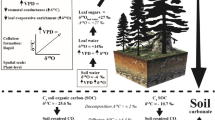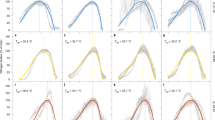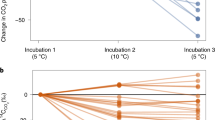Abstract
Because tree cellulose is formed from carbon acquired through photosynthesis, its 13C/12C isotope ratio reflects that of atmospheric CO2. Fractionation changes related to photosynthetic reactions also influence 13C/12C values, and an offset between atmospheric and tree cellulose isotope ratios results. Here, we measured the pre-1850 cellulose 13C/12C isotope ratios of 19 North American coniferous trees and found a strong dependency of the ratios on latitude. Relative humidity and perhaps temperature appear to be important for this relationship. Assuming climate change to be the dominant factor influencing pre-1850 tree cellulose isotope ratios, we compare a 2,000-yr-long record of 13C/12C isotope change with existing records of ice acidity and temperature1. When accepting a lag in 13C/12C response to climatic change of 70 to 90 yr, correlation coefficients of 0.8 are found for the 1100–1850 interval.
This is a preview of subscription content, access via your institution
Access options
Subscribe to this journal
Receive 51 print issues and online access
$199.00 per year
only $3.90 per issue
Buy this article
- Purchase on Springer Link
- Instant access to full article PDF
Prices may be subject to local taxes which are calculated during checkout
Similar content being viewed by others
References
1. Hammer, C. U., Clausen, H. B. & Dansgaard, W. Nature 288, 230–235 (1980). 2. Francey, R. J. & Farquhar, G. D. Nature 297, 28–31 (1982). 3. Freyer, H. D. Proc. Int. Meet. Stable hot. Tree–Ring Res. New Paltz, New York, May 22–25, 1979 (ed. Jacoby, G. C.) 13–21 (US Dept of Energy, Washington DC, 1980). 4. Long, A. in Climate from Tree Rings (eds Hughes, M. K. Kelley, P. M. Pilcher, J. R. & LaMarche, V. C.) 12–18 (Cambridge University Press, 1982). 5. Stuiver, M. & Burk, R. L. in Paleoclimate Analysis and Modeling (ed. Hecht, A. D.) 151–161 (Wiley, New York, 1985). 6. Pearman, G. I., Francey, R. J. & Fraser, P. J. B. Nature 260, 771–773 (1976). 7. Wilson, A. T. & Grinsted, M. J. Nature 265, 133–135 (1977). 8. Freyer, H. D. & Belacy, N. /. geophys. Res. 88, 6844–6852 (1983). 9. Tans, P. P. thesis, Univ. Groningen, Groningen, the Netherlands (1978). 10. Leavitt, S. W. & Long, A. Tellus 35B, 92–102 (1983). 11. Leavitt, S. W. & Long, A. Isotope Geoscience 1, 169–180 (1983). 12. Winter, K., Holtum, J. A. M., Edwards, G. E. & O'Leary, M. H. /. exp. Botany 33, 88–91 (1982). 13. Winter, K. Z. Pflanzenphysiol. 101, 421–430 (1981). 14. Francey, R. J. Nature 290, 232–235 (1981). 15. Harkness, D. D. & Miller, B. F. Radiocarbon 22, 291–298 (1980). 16. Lerman, J. C. & Long, A. Proc. Int. Meet. Stable hot, Tree–Ring Res. New Paltz, New York, May 22–25, 1979 (ed. Jacoby, G. C.) 22–32 (US Dept of Energy, Washington DC, 1980). 17. Rebello, A, & Wagener, K. Environmental Biogeochemistry Vol. 1 (ed. Nriagu, J. O.) 13–24 (Ann Arbor Science, Ann Arbor, Michigan, 1976). 18. Tans, P. P. & Mook, W. G. Tellus 32, 268–283 (1980). 19. Bender, M. & Berge, A. J. Tellus 34, 500–504 (1982). 20. Grinsted, M. J., Wilson, A. T. & Ferguson, C. W. Earth planet. Sci. Lett. 42,251–253 (1979). 21. Galimov, E. M. Environmental Biogeochemistry Vol. 1 (ed. Nriagu, J. O.) 3–12 (Ann Arbor Science, Ann Arbor, Michigan, 1976). 22. Farmer, J. G. & Baxter, M. S. Nature 247, 273–275 (1974). 23. Farmer, J. G. Nature 279, 229–231 (1979). 24. Lerman, J. C., Mook, W. G. & Vogel, J. C. in Radiocarbon Variations and Absolute Chronology Nobel Symp. 12 (ed. Olsson, I. U.) 275–299 (Wiley, New York, 1970). 25. Hakansson, S. Quat. Sci. Rev. 4, 135–146 (1985). 26. Stuiver, M., Burk, R. L. & Quay, P. D. J. geophys. Res. 89, 11731–11748 (1984). 27. Stuiver, M. & Quay, P. D. Science 207, 11–19 (1980). 28. Ramesh, R., Bhattacharya, S. K. & Gopalian, K. Earth planet. Sci. Lett. 79, 66–74 (1986). 29. Freyer, H. D. Proc. 6th Oak Ridge Life Sciences Symp. Oak Ridge (eds Trabalka, J. R. & Reichle, D. E.) 125–151 (Springer, New York, 1986). 30. Gedzelman, S. D. The Science and Wonders of the Atmosphere 200–203 (Wiley, New York, 1980). 31. Dansgaard, W. in Climatic Variations and Variability: Facts and Theories (ed. Berger, A.) 193–206 (NATO Advanced Study Institute Series, Reidel, Dordrecht, 1980). 32. Yapp, C. J. & Epstein, S. Earth planet. Sci. Lett. 34, 333–350 (1977).
Author information
Authors and Affiliations
Rights and permissions
About this article
Cite this article
Stuiver, M., Braziunas, T. Tree cellulose 13C/12C isotope ratios and climatic change. Nature 328, 58–60 (1987). https://doi.org/10.1038/328058a0
Received:
Accepted:
Issue Date:
DOI: https://doi.org/10.1038/328058a0
This article is cited by
-
Bulk and compound-specific δ13C and n-alkane indices in a palustrine intermontane record for assessing environmental changes over the past 320 ka: the Padul Basin (Southwestern Mediterranean realm)
Journal of Iberian Geology (2021)
-
The relationship of C and N stable isotopes to high-latitude moss-associated N2 fixation
Oecologia (2021)
-
Site-specific climatic signals in stable isotope records from Swedish pine forests
Trees (2018)
-
Tree-ring stable carbon isotope-based April–June relative humidity reconstruction since ad 1648 in Mt. Tianmu, China
Climate Dynamics (2018)
-
Search for Trends and Periodicities in Inter-hemispheric Sea Surface Temperature Difference
Pure and Applied Geophysics (2018)
Comments
By submitting a comment you agree to abide by our Terms and Community Guidelines. If you find something abusive or that does not comply with our terms or guidelines please flag it as inappropriate.



